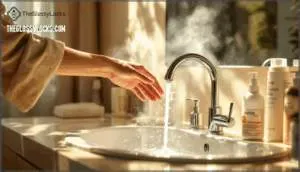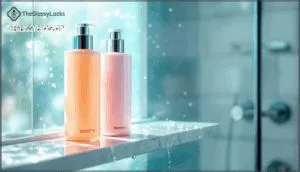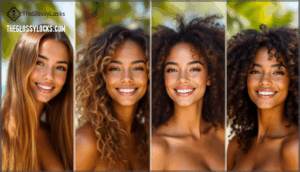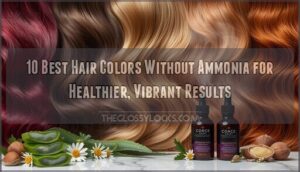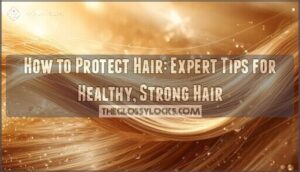This site is supported by our readers. We may earn a commission, at no cost to you, if you purchase through links.
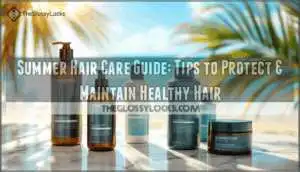
The good news? Most of this damage is preventable. A solid summer hair care routine doesn’t require complicated steps or expensive treatments—just the right knowledge about what works and why. Here’s how to keep your hair healthy, strong, and vibrant all season long.
Table Of Contents
- Key Takeaways
- How Summer Damages Your Hair
- Building a Summer Hair Care Routine
- Essential Tips for Healthy Summer Hair
- Protecting Hair From Sun and Environmental Damage
- Adapting Hair Care by Hair Type
- Frequently Asked Questions (FAQs)
- What are the best hairstyles for summer that don’t require heat styling?
- How often should I trim my hair in the summer months?
- How often should I trim my hair during summer?
- Can I use regular conditioner as a leave-in product?
- Whats the best way to dry hair after swimming?
- Should I change my hair routine for vacation travel?
- How do I know if my hair is heat-damaged versus dehydrated?
- Conclusion
Key Takeaways
- UV rays weaken hair’s keratin proteins by 14% and reduce tensile strength by up to 50% when combined with heat above 155°C, making sun and heat damage your biggest summer threat.
- Pre-wetting hair with fresh water before swimming reduces chlorine absorption by 80%, while weekly deep conditioning increases moisture retention by 28% and cuts breakage significantly.
- Physical barriers like UPF 50 hats block 98% of UV rays and protective styles reduce breakage by 40%, outperforming chemical protection alone.
- Your hair type needs customized care—straight hair needs keratin-rich products, wavy/curly hair needs frizz-control polymers, and coily hair needs protein reconstructors and protective styling to combat summer damage effectively.
How Summer Damages Your Hair
Summer is tough on your hair. Between the sun’s powerful UV rays, heat, humidity, chlorine, and saltwater, your hair faces constant attacks that leave it drier, weaker, and more prone to breakage.
Summer’s UV rays, heat, humidity, chlorine, and saltwater wage constant assault on your hair, leaving it drier, weaker, and prone to breakage
Understanding what summer does to your hair is the first step toward protecting it—so let’s break down exactly how these elements damage your locks.
Effects of Sun and UV Exposure
Summer sunlight hits your hair harder than you might think. UV rays penetrate deep, weakening keratin proteins and reducing tensile strength by about 14%. UVB radiation proves especially damaging—roughly two to five times more harmful than UVA.
This UV hair damage triggers lipid oxidation, breaking down protective oils and increasing porosity by over 139%. Your hair loses moisture fast, becoming brittle and dull. Pigment degradation fades color noticeably, while follicle aging accelerates graying.
The good news? Protective mechanisms like UV filters and antioxidants combat these effects, maintaining your hair’s strength and vibrancy. Extensive exposure can even lead to fusion of cuticle cells.
Impact of Heat, Humidity, and Pollution
Beyond UV damage, summer layers on additional stressors. Heat and humidity work together—when temperatures rise, your hair absorbs moisture, swelling by about 16% and weakening the structure that holds everything together. That’s where humidity effects become serious.
Here’s what’s happening simultaneously:
- Heat-Induced Damage: Temperatures above 155°C denature keratin proteins, reducing tensile strength by up to 50% after repeated styling sessions.
- Humidity Effects: High moisture levels accelerate protein breakdown in hair, compounding UV damage and creating a cycle of swelling and shrinking that fractures cuticles.
- Pollution Exposure: Urban pollutants like PM2.5 and diesel particles trigger oxidative stress, degrading the hair cortex and disrupting growth cycles within days of exposure spikes.
- Combined Stressors: When heat, humidity, and pollution interact, keratin oxidation accelerates dramatically—pollution-exposed hair degrades 30% faster under UV radiation than uncontaminated hair.
The preventive mechanism? Antioxidant treatments reduce free radical formation by 40%, while thermal protectants and barrier conditioning minimize accumulated damage. Your best defense combines these protective approaches. Understanding how humidity affects hair is key for summer hair care.
Chlorine and Saltwater Damage
While heat and humidity stress your strands, chlorine and saltwater present different threats. Chlorine binds with hair proteins, stripping natural oils and reducing moisture retention by up to 35%. This chemical binding weakens keratin structure, causing brittleness and frizz. Saltwater works similarly—its high sodium content draws moisture from hair shafts, decreasing tensile strength by over 20% with repeated exposure. Color-treated hair suffers most; chlorine causes up to 40% pigment loss within weeks, while saltwater accelerates fading by 45% after just ten swims.
| Damage Type | Effect | Severity |
|---|---|---|
| Chlorine Binding | Protein denaturation, elasticity loss | High |
| Moisture Loss | Brittleness, increased porosity | High |
| Color Fading | Pigment degradation, lightening | Very High |
| Saltwater Dehydration | Tensile strength reduction | Moderate-High |
| Green Hair (Copper) | Discoloration on blonde hair | Moderate |
Pre-wetting your hair with fresh water before swimming decreases chlorine absorption by 80%. Applying conditioner or silicone sealants creates a protective barrier, reducing chemical infiltration by 60%. Immediate rinsing after swimming and weekly deep conditioning restore hydration and combability by 25–35%, helping you maintain healthy summer hair despite these environmental stressors.
Increased Hair Porosity and Breakage
All that chlorine and saltwater damage adds up—literally. UV-induced porosity transforms your hair’s structure at the cellular level. UV radiation causes protein loss that weakens disulfide bonds holding your strands together. Environmental stressors like pollution intensify this damage, creating microscopic fractures that evolve into visible breakage.
Here’s what happens when your hair becomes porous:
- Cuticle damage allows moisture to escape, leaving hair brittle and prone to snapping
- Protein loss reduces elasticity by up to 30%, making strands less resilient to stress
- Increased porosity means faster color fading and reduced dye retention
- Weakened tensile strength makes hair 20–30% more fragile than untreated samples
- Environmental damage accelerates, with combined UV and pollution creating synergistic weakening
High-porosity hair can’t hold onto moisture or color. That’s why the damage from summer compounds—each stressor builds on the last, leaving your hair structure compromised and breakage rates climbing.
Building a Summer Hair Care Routine
Now that you know how summer threatens your hair, it’s time to build a routine that actually works. The good news is you don’t need expensive products or complicated steps—just the right approach to washing, conditioning, and protecting what you’ve got.
Here’s what matters most during the warmer months.
Adjusting Hair Washing Frequency
Your hair’s washing frequency isn’t one-size-fits-all during summer—it depends on your scalp condition and lifestyle. Most people benefit from washing every 1-3 days to prevent summer sweat buildup while maintaining scalp microbiome balance. Use sulfate-free shampoos with hydrating conditioners to avoid stripping natural oils.
If you swim regularly or sweat heavily, daily washing may be necessary. Conversely, dry hair types need less frequent washing—just 1-2 times weekly.
The key is seasonal adjustments: observe how your scalp reacts to heat, then adjust your hair cleansing routine accordingly.
Choosing Summer-Friendly Shampoos and Conditioners
The right summer shampoo and conditioner combo is your first line of defense. Look for sulfate-free formulas that won’t strip your hair’s natural oils, paired with hydrating ingredients like glycerin and ceramides. Color-safe options with UV filters protect against fading and environmental damage.
A clarifying shampoo weekly removes chlorine and saltwater buildup. Strong scalp health underpins everything else—choose products that maintain your scalp’s natural pH balance while keeping moisture locked in.
Weekly Deep Conditioning and Hair Masks
Weekly deep conditioning is where your summer hair care truly transforms. Think of these treatments as intensive repairs that penetrate 15% deeper into your hair’s core than regular conditioners, rebuilding what sun and chlorine tear down. Aim for once weekly—this frequency increases moisture retention by 28% compared to biweekly routines, while keratin-based masks can more than double hair strength in just weeks.
The science backs it up:
- Deep conditioning enhances your hair’s water-binding capacity by up to 35%, combating summer dehydration
- Argan oil and shea butter formulations decrease protein loss by roughly 33% after saltwater exposure
- Weekly treatments reduce chlorine absorption by 25%, preventing cuticle swelling and discoloration
- Panthenol-infused masks consistently boost elasticity by 15%, restoring resilience after UV stress
Leave masks on for 15–20 minutes—summer’s higher scalp temperatures speed absorption. Don’t overdo it beyond three times weekly, though; excessive conditioning creates buildup that weighs hair down.
Incorporating Leave-in and Detangling Products
Leave-in conditioners and detangling sprays work like a one-two punch for summer stress. Leave-ins boost moisture retention by 35% while reducing frizz, and when paired with detanglers, they cut detangling time in half—from 7.5 to 3 minutes.
Apply to towel-dried hair for 27% better absorption. Spray formats distribute product 33% more evenly across your strands. Focus on mid-lengths and ends to prevent root buildup.
UV-filtered formulations shield against keratin degradation, keeping your color vibrant and your hair strong through peak sun months.
Essential Tips for Healthy Summer Hair
You’ve already built the foundation for healthy summer hair. Now it’s time to focus on the everyday habits that’ll keep your hair strong and resilient through the season.
From cutting back on heat styling to nourishing from the inside out, these tips address the root causes of summer damage and help you maintain that healthy shine.
Minimizing Heat Styling Tools
Want to know the real culprit behind summer hair damage? Heat styling tools. Here’s why you should step back from them during summer months:
- Hot tools strip essential oils, causing up to 70% more split ends and breakage over time
- Heat styling accelerates color fading by 40% in treated hair, especially when combined with summer sun
- Air-drying instead of blow-drying maintains hydration and reduces frizz by up to 25%
- Using heat protectant products can reduce thermal damage by up to 50% after just 10 uses
- Limiting heat styling to twice weekly cuts hair shaft weakening risk in half
Heatless styling methods like braids and air-drying eliminate damage entirely while improving air quality indoors. Temperature control matters—but skipping hot tools altogether is your best defense this summer.
Staying Hydrated for Hair Health
Your body’s hydration directly fuels your hair’s strength. About 25% of a healthy hair strand is water, making adequate intake essential for maintaining elasticity and shine. Aim for at least 8 ounces of water daily to support scalp hydration and nutrient transport to follicles.
When you’re dehydrated, your hair loses resilience and becomes prone to breakage—especially under environmental stress like summer heat and chlorine exposure. Electrolyte balance matters too; potassium and magnesium help maintain follicular hydration and prevent brittleness.
Staying hydrated strengthens your hair from the inside out, giving you the freedom to enjoy summer without sacrificing hair health.
Regular Trims to Prevent Split Ends
Here’s where split ends come into play. A trim every 6–8 weeks cuts away damaged ends before they travel upward, stopping breakage in its tracks. Different hair types need different schedules—curly and textured hair benefits from trims every 8–10 weeks due to lower oil distribution, while chemically treated hair may need cuts every 5–6 weeks.
Why trim frequency matters:
- Removes existing damage — Cutting 0.25–0.5 inches eliminates split ends entirely, preventing 50–60% tensile strength reduction that worsening splitting causes.
- Prevents upward splitting — Regular trims stop splits from traveling up your hair shaft, preserving length over time.
- Improves product effectiveness — Smoother cuticles from trimming boost conditioner efficacy by 10–12%, enhancing your overall hair health.
Professional stylists recommend this approach because it’s the only way to completely eliminate split ends—products alone show just 40% effectiveness after six weeks.
Using Hot Oil and Deep Treatments
While trims stop splits, they can’t repair damage that’s already traveled deeper into your hair. That’s where hot oil and deep conditioning treatments come in.
A weekly deep conditioning mask boosts moisture by 35% in UV-exposed hair, while hot oil treatments improve retention by up to 30%. The real magic happens when you combine them—oils coat your cuticles and reduce protein loss by 35%, while deep conditioners restore up to 60% of lost surface lipids.
Warm oil massages also increase blood flow to your scalp by 30–40%, feeding your follicles the nutrients they need. Use them together every week, and you’ll see 28–32% less breakage within eight weeks.
Protecting Hair From Sun and Environmental Damage
Your hair faces a lot during summer—UV rays damage the structure and color of each strand, while humidity, pollution, and chlorine work together to dry things out and cause breakage.
The good news is that smart protection strategies can shield your hair from these stressors. Here’s what you need to know to keep your hair strong and healthy all season long.
Applying Hair Sunscreens and UV Protection
Sun damage isn’t just about faded color—UV rays trigger oxidative stress that degrades your hair’s proteins and melanin, weakening its structure. Hair sunscreens with UV filters like benzophenone-4 form protective barriers against both UVA and UVB rays.
Apply leave-in protective formulations every 2-3 hours or after swimming, since heat and sweat break them down. Look for products combining UV filters with antioxidants and hydrating oils for maximum efficacy.
Pairing chemical protection with mechanical barriers boosts defense by 40-60%.
Wearing Hats, Scarves, and Protective Styles
While chemical sunscreen offers real protection, physical barriers work harder. A UPF 50 hat blocks 98% of UV rays—that’s serious defense. Scarves and headwraps shield your scalp and hairline, especially areas most vulnerable to fading and sun damage.
Protective styles like cornrows and low-tension twists do double duty: they minimize UV exposure while reducing breakage by up to 40%. Tight braids? Skip those—they stress your scalp. Rotate your styles throughout summer to balance moisture and prevent localized strain.
Material matters too. Dense fabrics like canvas and polyester blends maintain strong UPF ratings, while loose-weave straw allows more rays through. Choose breathable materials—silk or satin-lined options—to trap moisture and reduce friction. Combining hats with protective styling maximizes your defense and keeps your hair looking fresh, not fried.
Using Hair Sealants and Serums
Beyond physical barriers, hair sealants and serums form your strongest defense against summer’s assault. These lightweight formulations create a protective shield that reduces moisture loss by up to 35% in high-humidity environments while cutting UV-induced protein breakdown by 41%. Here’s what makes them essential:
- Frizz Control: Serums decrease surface roughness by 28% after four weeks, taming humidity-triggered frizz by over 50%
- Scalp Health: Botanical oil-based sealants lower pollutant penetration into hair cuticles by 29% during peak summer pollution
- Moisture Retention: Humectant-based serums sustain hydration for up to 48 hours post-application versus 12–18 hours without protection
- Growth Support: Clinical studies show 34% reduction in visible hair thinning with regular herbal serum applications
- Market Trends: Professionals now integrate serums into 36% of summer treatment packages as demand for natural, silicone-free formulations grows 21% annually
Choose serums with silicone derivatives or jojoba oil for maximum protection. Apply to damp hair before sun exposure and after swimming to lock in moisture and shield against chlorine and saltwater damage.
Preventing Color Fading and Green Hair
If you color-treat your hair, summer’s UV rays and chlorine are working against you. UV exposure fades artificial dyes by 20–30% after just two weeks of direct sun exposure, while chlorine damages your hair cuticle and increases copper absorption by 30%, causing that unwanted green tint.
Protect your color by using color-safe shampoos with pH between 4.5–5.5, which retain 30% more color intensity than alkaline products. Pre-swim, wet your hair with fresh water and apply leave-in conditioner to reduce copper and chlorine uptake by 40–50%. After swimming, use chelating treatments to remove mineral buildup and restore vibrancy.
Wear UV-protective hats during peak sun, and deep condition weekly with UV filters to decrease fading by 28%. These hydration and UV protection strategies keep your color vibrant all season.
Adapting Hair Care by Hair Type
Not all hair is created equal, and summer throws different curveballs depending on what you’re working with. Your straight hair has different needs than someone’s coils, and humidity affects them in completely different ways.
Here’s how to keep your specific hair type happy and healthy all season long.
Summer Care for Straight Hair
Straight hair faces unique summer challenges. UV rays degrade keratin proteins, reducing strength by up to 25%, while humidity causes lipid loss that strips shine and elasticity. Chlorine sebum stripping weakens your scalp’s natural barrier.
Counter this with sulfate-free shampoos containing keratin, pH-balanced products (4.5–5.5) that maintain cuticle closure, and heat protectants that reduce styling damage by 30%. Weekly hydrating masks restore moisture.
Hair sunscreen with SPF 30 blocks 90% of UVB rays, protecting against protein degradation and color fading.
Managing Wavy and Curly Hair in Humidity
Humidity is wavy and curly hair’s trickiest opponent. When moisture levels spike above 70%, your hair absorbs water, swelling strand diameter by 16% and disrupting curl structure. That’s where frizz control becomes essential.
Your product selection matters hugely—styling gels with polyquaterniums boost curl definition by 40%, while leave-in conditioners with low-molecular-weight silicones reduce water permeability by 18–22%. Weekly deep conditioning boosts moisture retention by 25%, locking hydration inside.
For protective styles, use microfiber towels or cotton T-shirts when drying to cut cuticle disruption by 30%. Satin or silk coverings at night slash next-day frizz by 43%, keeping your curls defined and controlled through humid summer months.
Protecting Coily and Textured Hair
Coily and textured hair faces unique summer challenges—your natural porosity makes it absorb 1.5 times more water than straight hair, leading to expansion stress and breakage.
Combat this with strategic hydration strategies:
- Deep condition weekly with shea butter and avocado oil to improve elasticity and reduce breakage by up to 35%
- Use protective styling like braids and twists to minimize UV exposure while distributing natural oils down your shaft
- Apply protein reconstructors to restore disulfide bonding and strengthen tensile strength by approximately 25%
Pair these with sulfate-free shampoos and moisture-sealing oils to maintain scalp health and control porosity year-round.
Customizing Products for Hair Needs
One-size-fits-all products rarely work for summer hair. That’s where AI formulations and ingredient personalization come in—today’s brands use data from 85+ factors like your hair porosity, texture, and scalp condition to build custom solutions. The individual hair care market reached $5 billion in 2025, with 60% of consumers preferring formulations made to order over generic ones.
Whether you need protein-rich treatments for breakage-prone hair or lightweight hydration for fine textures, products made to order address your specific needs. Genetic haircare and sustainable individualization options let you control exactly what touches your strands—no guesswork required.
| Hair Type | Key Challenge | Recommended Ingredient | Product Focus |
|---|---|---|---|
| Straight | Oil buildup | Clarifying botanicals | Lightweight shampoo |
| Wavy | Frizz control | Hydrating polymers | Leave-in conditioner |
| Curly | Moisture retention | Shea butter & glycerin | Deep conditioner |
| Coily | Breakage & shrinkage | Keratin & amino acids | Protein treatment |
| Fine/Delicate | Porosity overload | Green tea & caffeine | Scalp customization |
Frequently Asked Questions (FAQs)
What are the best hairstyles for summer that don’t require heat styling?
Braids, buns, ponytails, and half-up styles dominate heatless summer looks. Try space buns, top knots, twisted knot variations, or beach waves achieved through braiding and air-drying.
These protective styles reduce breakage while keeping you cool and stylish without damaging your hair.
How often should I trim my hair in the summer months?
Trim your hair every 6 to 8 weeks during summer to prevent split ends and combat environmental damage. More frequent trims support hair growth by stopping breakage from traveling up the shaft.
Regular trims also maintain style while managing humidity-induced frizz and damage.
How often should I trim my hair during summer?
Aim for trims every 6-8 weeks during summer to combat split ends and environmental damage. Your hair growth goals and damage level matter—fine or chemically treated hair needs cuts every 4-6 weeks, while longer styles can stretch to 8-10 weeks.
Regular trimming removes up to 70% of split ends, preventing breakage and keeping your healthy hair growth on track.
Can I use regular conditioner as a leave-in product?
As the saying goes, "you can’t pour from an empty cup"—and the same applies to your hair’s moisture reserves. Regular rinse-out conditioners aren’t formulated to stay in your hair, so using them as leave-in products risks conditioner buildup, scalp irritation, and dull, weighed-down strands.
Professional advice is clear: stick with lightweight leave-in conditioners designed for extended wear to maintain proper hydration levels without compromising your hair’s health.
Whats the best way to dry hair after swimming?
Pat your hair dry with a microfiber towel instead of rubbing—this minimizes friction and prevents hygral fatigue from weakening your strands.
Avoid air-drying in prolonged dampness, which risks fungal infections. If you do air-dry, make sure your scalp dries completely to prevent scalp issues.
Should I change my hair routine for vacation travel?
Yes, absolutely. Vacation travel disrupts your routine, so adapt accordingly. Pack travel-sized summer hair care products to maintain protection against sun damage and environmental stress.
Your destination’s climate impacts hair differently—humid climates demand extra moisture; dry ones need sealants.
Choose low-maintenance hairstyles that survive travel and require minimal styling.
Plan post-travel recovery with deep conditioning treatments to restore moisture and repair accumulated damage from travel exposure.
How do I know if my hair is heat-damaged versus dehydrated?
Heat damage cracks your hair’s cuticle and denatures proteins, causing brittleness, split ends, and dullness. Dehydrated hair loses moisture but keeps its cuticle intact, feeling rough and tangled.
Check for visible cuticle damage and brittleness to spot heat damage; if hydration treatments restore elasticity, you’re dealing with dryness, not heat harm.
Conclusion
Your summer hair care routine is your best defense against the elements. Think of it as building armor—each step protects what matters. By combining UV protection, moisture-rich products, and smart styling choices, you’re not just reacting to damage; you’re preventing it.
A solid summer hair care guide keeps your strands strong, shiny, and resilient all season. Consistency wins here. Stick with these practices, and you’ll notice healthier hair that actually holds onto its vitality through heat, humidity, and everything else summer throws your way.
- https://www.esteticaexport.com/7-scalp-first-trends-that-will-shape-summer-2025-and-why-export-managers-should-pay-attention/
- https://beautymatter.com/articles/2025-trends-whats-next-for-haircare
- https://onlinelibrary.wiley.com/doi/10.1111/jocd.16442
- https://pmc.ncbi.nlm.nih.gov/articles/PMC9804959/
- https://www.sciencedirect.com/science/article/abs/pii/S0891584918307238

